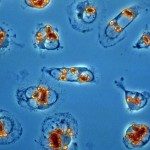Link to Pubmed [PMID] – 33869086
Link to DOI – 10.3389/fcimb.2021.655700
Front Cell Infect Microbiol 2021 ; 11(): 655700
Casein Kinase 1 (CK1) family members are serine/threonine protein kinases that are involved in many biological processes and highly conserved in eukaryotes from protozoan to humans. Even though pathogens exploit host CK1 signaling pathways to survive, the role of CK1 in infectious diseases and host/pathogen interaction is less well characterized compared to other diseases, such as cancer or neurodegenerative diseases. Here we present the current knowledge on CK1 in protozoan parasites highlighting their essential role for parasite survival and their importance for host-pathogen interactions. We also discuss how the dual requirement of CK1 family members for parasite biological processes and host subversion could be exploited to identify novel antimicrobial interventions.



